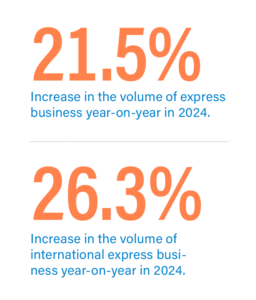
Globalisation is alive and well
After several years of increasing geopolitical turbulence and the launch of a ‘tariff war’ by the new president of the United States (US), it might seem reasonable to conclude that globalisation is in retreat. However, as Elaine Chen and Jane Su argue, the data does not necessarily support this.
Is globalisation now in reverse? With wars raging in the Middle East and Ukraine, rising protectionism and low levels of international consensus, this might seem like a fair conclusion. Donald Trump’s recent launch of a tariff war on China and several US allies only adds weight to this view.
However, the latest edition of the DHL Global Connectedness Report (Report), published by New York University in partnership with DHL, unveiled a remarkable finding: globalisation reached a record high in 2022 and remained close to that level in 2023. Trade growth is forecast to accelerate substantially in 2024, growing at a slightly faster rate than gross domestic product (GDP).[1]

This finding was based on a comprehensive analysis of data on global trade, capital, information and people flows since 2011. Given the widespread debate about the end of globalisation, this result might come as a surprise to many, but the data speaks for itself. It is further supported by the growth of China’s logistics industry, the engine of global physical flows. According to the China Federation of Logistics & Purchasing, China’s logistics market size in 2024 is expected to rank first in the world, a position the industry would then have held for nine consecutive years.[2] Also, according to statistics for 2024 released by the State Post Bureau, the volume of express business increased by 21.5 per cent year-on-year. Even under challenging trade conditions, the volume of international express business still increased by 26.3 per cent year-on-year, much higher than any other service category.[3]
Resilience and growth of international trade flows
According to the Report, the share of international trade in global GDP declined significantly after the 2008 global financial crisis, but was back to a record high in 2022, driven by strong growth of merchandise trade volumes, elevated commodity prices and recovering services trade.
Accelerated growth of cross-border e-commerce is one example of this. E-commerce boomed during the pandemic due to lockdowns and changes in consumption habits (such as more online purchases and less in-person contact in retail stores). This brought new opportunities to access overseas markets for Chinese sellers, and industry experts forecast the industry’s continued growth. The dynamic has changed a little: Chinese merchandise now flows less to top destinations such as the US, and instead flows more to emerging markets in Southeast and South Asia, South America and the Middle East. Also, direct shipping has become less popular than overseas warehousing or consolidated shipping, with the lower costs of the latter two leading consumers to buy more.
Globalisation vs. regionalisation: the shifting landscape of global trade
Geopolitical tensions and concerns about supply chain resilience have prompted many observers to predict a shift from globalisation to regionalisation. But is it actually happening?
Ties between the US and China, the world’s two biggest economies, continue to diminish: the shares of both countries’ trade flows involving the other have fallen by about one quarter since 2016. This trend accelerated in 2023, and may worsen under the new Trump administration. At first glance, this might seem like bad news for globalisation. However, the US and China still have the largest bilateral trade flows in the world.[4] Furthermore, global trade flows show no general split of the world economy between rival geopolitical blocs. The share of trade between the major trade partners of the US and China actually increased during the Covid-19 pandemic, because countries around the world relied more on goods from Asia, especially from China. Besides, trade between the two sides is often routed through third countries. Trade continues, but flows less directly than before.
International trade flows are now covering longer distances than they did before, partly due to geopolitical tensions, with declines happening inside some geographical regions. Focussing specifically on trade, only North America shows a clear nearshoring trend. Another reason for the longer distances is that more trade growth is happening in emerging economies, which has expanded opportunities for exchange between geographical regions.
Corporate globalisation continues to advance too, as companies are making more of their sales abroad and the value of announced international business deals is at its highest level relative to global GDP in more than a decade. The cross-border share of mergers and acquisitions is holding steady, as is the share of global output that companies produce outside of their home countries.
A mixed picture: challenges and opportunities
The second Trump administration may cause uncertainty and challenges for China, the European Union and many other major economies. Although extreme protectionist moves might be impractical for most economies, using tariffs and sanctions is likely to become more common. The looming threats are pushing more outbound Chinese investments, and diversified trade relations with economies other than the US to help Chinese companies mitigate geopolitical risks. Amid insufficient domestic demand and increased competitiveness, China’s business leaders are increasingly looking for global opportunities. The new wave of ‘going overseas’ is not limited to increasing exports from China, but also involves directly investing in other countries, especially emerging markets. A representative example is the opening of Chancay Port in Peru in November 2024, a Chinese-funded mega port which is seen as China’s new gateway to South America.
The second challenge is the difficulty with international data flows and technology partnerships. Tensions between the US and China have weighed on technology exchanges, and many countries have imposed data transfer restrictions. The release of DeepSeek is one example: while it attracted global attention at an unprecedented speed, it was also quickly subject to restrictive measures from many major economies.
Challenges and opportunities coexist because the world’s absolute level of globalisation remains limited, and domestic flows still far exceed international flows. The world’s current depth of global connectedness is only 25 per cent on a scale from zero per cent (no flows across national borders) to 100 per cent (borders and distance no longer matter). Even after decades of globalisation, the world is still far from globalised.[5]
How logistics is changing
The post-pandemic era is often referred to as the ‘new norm’, but the current trade climate is dynamic and is constantly shifting and evolving, driven by new business models and technologies. Logistics, as an essential part of daily life, must adapt to this dynamic and always be ready for transformation. In 2024, two trends stand out the most in logistics worldwide: artificial intelligence (AI) and sustainability.
AI technology can be used in a multitude of ways within the logistics sector. A prime example is computer vision, which tracks the end-to-end movement of goods by scanning their unique identifiers, such as QR codes, thereby enhancing the punctuality and accuracy of order fulfilment and increasing the transparency of the shipping process. Additionally, advanced analytics facilitates mass personalisation by sifting through big data to discern patterns in customer behaviour and preferences, helping e-commerce businesses to strategise proactively and offer a more tailored service. Furthermore, AI-driven route-planning software can revolutionise ‘last-mile’ logistics by analysing real-time traffic data to determine the most efficient delivery routes.
The sustainability trend is spotlighted by the utilisation of sustainable fuels, which is essential to reduce carbon emissions and improve logistics efficiency, especially in aviation, a top source of carbon emissions. Use of sustainable aviation fuels (SAF) can help cut CO2 emissions by up to 80 per cent. The RefuelEU Aviation Regulation already mandates a two per cent SAF target for airport fuel suppliers from 2025 and six per cent by 2030.[6] China is following suit and authorities took a series of actions in 2024: the Development Research Center for Sustainable Aviation Fuel was established in July for policy and standards research and formulation; a nationwide pilot programme for the application of SAF was launched in September, and 12 flights departing from four airports were refuelled with SAF. Production of SAF has also started to take off. Against the backdrop of the EU’s anti-dumping duties on Chinese biodiesel imports, Chinese biodiesel companies have begun to develop new markets, and China’s SAF production capacity is expected to increase dramatically in the next few years.
Conclusion
In the coming years, there will likely be more discussion of globalisation evolving, rather than ending or reversing, especially in the logistics sector. Companies might need to reconsider their global logistics networks to ensure they are secure, efficient and environmentally friendly. Diversified shipping lanes, multiple transportation modes and the utilisation of sustainable fuels can help logistics firms better prepare for changes and disruptions, as well as contribute to decarbonising their operations.
Elaine Chen is the national chair of the European Chamber’s Logistics Working Group.
Jane Su is public affairs manager of DHL Group China.
DHL is the leading
global brand in the logistics industry, offering an unrivalled portfolio of
logistics services ranging from national and international postal service, parcel
delivery, e-commerce shipping and fulfilment solutions, international express,
road, air and ocean transport to industrial supply chain management. With
sustainable business practices and a commitment to society and the environment,
the Group makes a positive contribution to the world. DHL Group aims to achieve
net-zero emissions logistics by 2050.
[1] Altman, S.A., and Bastian, C.R., DHL Global Connectedness Report 2024, NYU Stern School of Business, 2024, viewed 21st February 2025, p.8 <https://www.dhl.com/content/dam/dhl/global/delivered/documents/pdf/dhl-global-connectedness-report-2024-complete.pdf>
[2] China’s logistics market is expected to rank first in the world for nine consecutive years, China Federation of Logistics and Purchasing, 25th December 2024, viewed 19th February 2025, <http://www.chinawuliu.com.cn/zixun/202412/25/642802.shtml>
[3] The State Post Bureau announced the operation of the postal industry in 2024, State Post Bureau, 20th January 2025, viewed 19th February 2025, <https://www.spb.gov.cn/gjyzj/c100276/202501/460d02f2e54c4d0ebbba3a4f431d0042.shtml>
[4] Altman, S.A., and Bastian, C.R., DHL Global Connectedness Report 2024, NYU Stern School of Business, 2024, viewed 21st February 2025, p.16 <https://www.dhl.com/content/dam/dhl/global/delivered/documents/pdf/dhl-global-connectedness-report-2024-complete.pdf>
[5] Altman, S.A., and Bastian, C.R., DHL Global Connectedness Report 2024, NYU Stern School of Business, 2024, viewed 21st February 2025, p.7 <https://www.dhl.com/content/dam/dhl/global/delivered/documents/pdf/dhl-global-connectedness-report-2024-complete.pdf>
[6] ReFuelEU Aviation, European Commission, viewed 21st February 2025, <https://transport.ec.europa.eu/transport-modes/air/environment/refueleu-aviation_en>


Recent Comments